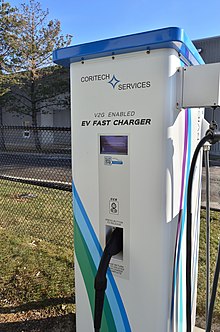
Vehicle-to-grid (V2G) describes a system in which plug-in electric vehicles (PEVs) sell demand response services to the grid. Demand services are either delivering electricity to the grid or reducing the rate of charge from the grid. Demand services reduce the peaks in demand for grid supply, and hence reduce the probability of disruption from load variations.[1][2][3] Vehicle-to-load (V2L) and Vehicle-to-vehicle (V2V) are related, but the AC phase is not synchronised with the grid, so the power is only available to "off-grid" load.
Plug-in electric vehicles include battery electric vehicles (BEVs), plug-in hybrids (PHEVs), and hydrogen vehicles. They share the ability to generate electricity which is typically used to power the vehicle. However, because cars spend most of the time parked, their energy remains stored. V2G allows some of this stored power to be sent to the grid, and reduces the need to take power from the grid. A 2015 report found that vehicle owners could receive significant payments by charging their EVs at off-peak times when electricity is cheaper, storing it in their car battery, and selling it back to the grid at peak times when electricity prices are higher.[4]
Batteries have a finite number of charging cycles, as well as a limited shelf-life, so V2G can reduce battery longevity. Battery capacity is a complex function of battery chemistry, charge/discharge rates, temperature, state of charge and age, but is improving as technology improves. Most studies of the effects of V2G on battery life show that slower V2G discharge rates lessen degradation, while one study suggested that using vehicles for grid storage could improve longevity.[5]
Hydrogen fuel cell vehicles (FCV) with tanks containing 5.6 kg of hydrogen can deliver more than 90 kWh of electricity.[6] Vehicle batteries may hold 100 kWh or more.
Uni-directional V2G (UV2G) charging is technically simpler than delivering power from an EV battery, which many PEVs are not equipped to do.[7] As of 2024[update], most EVs require a separate inverter than the one used to power the propulsion motors in order to output AC power from the battery. UV2G can be extended by throttling other activities such as air heating and cooling.[8][9]
- ^ Cleveland, Cutler J.; Morris, Christopher (2006). Dictionary of Energy. Amsterdam: Elsevier. p. 473. ISBN 978-0-08-044578-6.
- ^ "Pacific Gas and Electric Company Energizes Silicon Valley With Vehicle-to-Grid Technology". Pacific Gas & Electric. 2007-04-07. Archived from the original on 2009-12-09. Retrieved 2009-10-02.
- ^ Robledo, Carla B.; Oldenbroek, Vincent; Abbruzzese, Francesca; Wijk, Ad J.M. van (2018). "Integrating a hydrogen fuel cell electric vehicle with vehicle-to-grid technology, photovoltaic power and a residential building". Applied Energy. 215: 615–629. Bibcode:2018ApEn..215..615R. doi:10.1016/j.apenergy.2018.02.038. S2CID 115673601.
- ^ He, Y.; Bhavsar, P.; Chowdhury, M.; Li, Z. (2015-10-01). "Optimizing the performance of vehicle-to-grid (V2G) enabled battery electric vehicles through a smart charge scheduling model". International Journal of Automotive Technology. 16 (5): 827–837. doi:10.1007/s12239-015-0085-3. ISSN 1976-3832. S2CID 38215809.
- ^ Uddin, Kotub; Jackson, Tim; Widanage, Widanalage D.; Chouchelamane, Gael; Jennings, Paul A.; Marco, James (August 2017). "On the possibility of extending the lifetime of lithium-ion batteries through optimal V2G facilitated by an integrated vehicle and smart-grid system". Energy. 133: 710–722. Bibcode:2017Ene...133..710U. doi:10.1016/j.energy.2017.04.116.
- ^ Wassink, Jos (2016-07-18). "Hydrogen car as power backup". Delta TU Delft. Retrieved 2017-11-07.
- ^ Chukwu, Uwakwe C.; Mahajan, Satish M. (2014). "V2G parking lot with PV rooftop for capacity enhancement of a distribution system". IEEE Transactions on Sustainable Energy. 5 (1): 119–127. Bibcode:2014ITSE....5..119C. doi:10.1109/TSTE.2013.2274601. S2CID 33198534.
- ^ Yong, Jia Ying; et al. (2015). "A review on the state-of-the-art technologies of electric vehicle, its impacts and prospects". Renewable and Sustainable Energy Reviews. 49: 365–385. Bibcode:2015RSERv..49..365Y. doi:10.1016/j.rser.2015.04.130.
- ^ Sortomme, Eric; El-Sharkawi, Mohamed (2011). "Optimal charging strategies for unidirectional vehicle-to-grid". Smart Grid, IEEE Transactions on. 2 (1): 131–138. doi:10.1109/tsg.2010.2090910. S2CID 9522962.